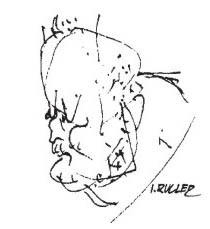
Architect Ivan Ruller will celebrate his eightieth birthday
 |
"There must be something like humility towards the place in architecture," says Ivan Ruller. He is closely connected to Brno through his life and work, and therefore he is critical of many urban design proposals in this city. He disapproves of relocating the Brno train station from the city center, as well as transforming the area near the Janáček Theatre into a parking lot. He has not hidden his disagreement regarding the Velký Špalíček either. However, he can acknowledge that there are many beautiful buildings in current works.
According to experts, he successfully combines "the rationally understood aspect of architecture with artistically conceived exterior and interior into a unified and often very effective emotional composition". It is typical of Ruller that the artistic component is always an equal partner to the architect's vision. His unprecedented collaboration with artists has contributed to the architectural refinement of buildings even during the era of socialist construction. He expressed his love for art by being a member of several artistic associations. He is one of the founders of the Q Association and the Group 58.
"In those days, I got to work on really atypical buildings - the International Hotel and the Janáček Theatre. Working on such works was exceptional," recalled architect Ruller. Among his significant projects are the glass building of Ingstav on Vienna Street, the building of the Karát goldsmith cooperative set into the context of historical development, and primarily the technically demanding Rondo hall.
Buildings designed by Ruller can also be found in Bratislava, at the Dalešice waterworks, in Kroměříž, Hodonín, as well as in Prague and elsewhere. The list of works that enhance the collection of modern Czech architecture includes over 500 items.
The work of architect Ruller, who was born on November 17, 1926 in Brno, clearly shows the influence of functionalism from the 1930s and modernism. He comes from the Brno school, where after World War II he studied under prominent architects of that time, among others under Bohuslav Fuchs and especially Bedřich Rozehnal, where he was already an assistant during his studies.
He gained his first experiences in the Brno Potravinoprojekt. He worked for five years at a school under Professor Miroslav Kopřiva, but in 1959 he had to leave involuntarily. He then worked at several design institutes - Stavoprojekt, Chemoprojekt, and Elektroprojekt Brno. From 1968 to 1979, he was at the Office of the Chief Architect, then he worked as an independent architect.
Architect Ruller participated in numerous projects and took part in both domestic and international competitions. Among his awarded proposals were, for example, the project for the Square of Nations in Geneva (1957), a study for a town hall in Toronto (1958), and the Czech pavilion in Osaka (1968). He collaborated on a memorial in Auschwitz and in Dakar. Under Chemoprojekt, he also contributed to the designs of refineries in Sri Lanka and Pakistan. From 1976 to 1981, he collaborated with UNESCO on building a history museum in Tripoli, Libya.
Abroad, he was and is a recognized figure. At home, however, he was held in disfavor by the former regime due to his positions and opposition to totalitarian practices. From 1970 to 1989, he was banned from membership in the Union of Architects and was not allowed to publish or teach for 20 years. However, he managed to maintain a distance and was not afraid to work with "forbidden" artists such as Vladimír Preclík or Olbram Zoubek.
Recognizing Ruller’s expertise and renown, he returned to the Technical University in 1990, where he was dean of the Faculty of Architecture for four years, became a professor in 1994, and still teaches in the Studio of Public Structures, passing on his experiences to students.
According to Ruller, the work of an architect is very demanding, and an architect must continually educate themselves in many fields. "Self-control is especially important," added the doyen of Czech architecture to his profession. His lifetime work was recently documented in a book with the succinct title - Architect Ivan Ruller.
Architect Ivan Ruller
Ludvík Kundera, Jan Jelínek, Josef Chybík
Publishing House VUTIUM, 2005
166 pages, B5, Czech
Regular price:220 CZK
Our price: 220 CZK (shipping time: up to 7 days)
Ludvík Kundera, Jan Jelínek, Josef Chybík
Publishing House VUTIUM, 2005
166 pages, B5, Czech
Regular price:
Our price: 220 CZK (shipping time: up to 7 days)
 |
The English translation is powered by AI tool. Switch to Czech to view the original text source.
0 comments
add comment







